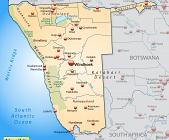In March Namibia is approaching the end of summer although temperatures are still high, averaging close to 30 degrees during the daytime and up to highs in the mid-40’s in desert regions.
Rainfall in Namibia is starting to lessen by March, although rainfall can still be frequent, typically in the form of late afternoon thunderstorms, normally lasting an hour or so, although occasionally continuing for longer periods.
From a safe vantage point, these tropical storms can be a spectacular sight, particularly with the backdrop of the photogenic Namibian landscapes.
Afternoon storms usually clear and freshen the air as the skies clear into the evening.
March is still low season for travel to Namibia and many of Namibia’s safari camps and hotels have special deals at this time of year and many simply close up for the season.
Game viewing in Namibia isn’t at it’s best in March as the vegetation is lusher and animals have no need to congregate around open waterholes, making them less easy to find.
Self-drives in Namibia during March may encounter some roads blocked by flooding. Much of Kaokoland and Bushmanland in particular may potentially be totally inaccessible by vehicle at this time of year, although less commonly than in January or February.
Namibia’s coastal regions see a climatic pattern similar to the rest of the country but with greater influence from land and sea air currents. A particular feature of this are vast fog banks which can spread tens of kilometres inland.



